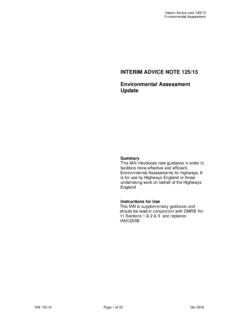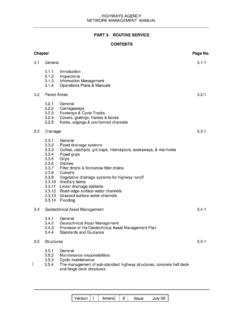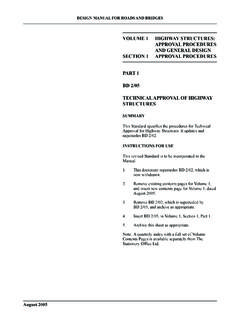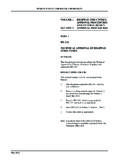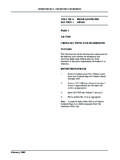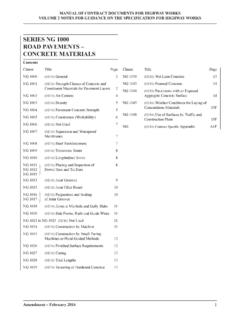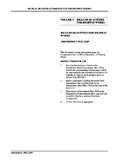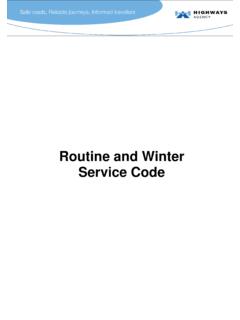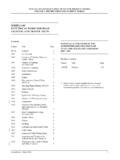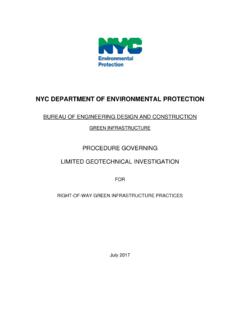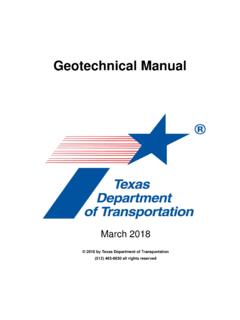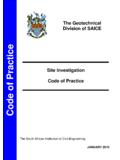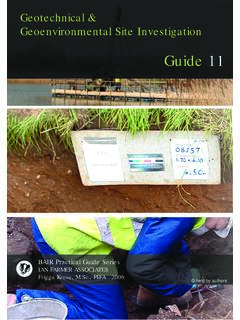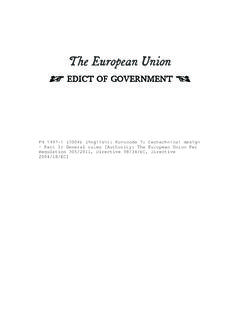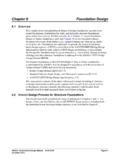Transcription of DMRB VOLUME 4 SECTION 1 - HD 22/08 - MANAGING …
1 VOLUME 4 geotechnics and drainage SECTION 1 earthworksPart 2hd 22/08managing geotechnical risksummarYThis Standard sets out the procedures to be followed and certificates to be used during the process of planning and reporting of all geotechnical Works carried out on highways under the jurisdiction of the relevant Overseeing Organisation to ensure that the geotechnical Risk is correctly for useThis revised Standard is to be incorporated in the This document supersedes HD 22/02, which is now Remove existing contents page for VOLUME 4 and insert new contents page for VOLUME 4 dated August Remove HD 22/02, which is superseded by HD 22/08 , and archive as Insert HD 22/08 in VOLUME 4, SECTION 1, Part Please archive this sheet as : A quarterly index with a full set of VOLUME Contents Pages is available separately from The Stationery Office manual for roads and Bridgesaugust 2008design manual for roads and Bridgeshd 22/08 VOLUME 4, SECTION 1, Part 2the highwaYs agencYscottish government welsh assemBlY government llYwodraeth cYnulliad cYmruthe dePartment for regional develoPment northern irelandManaging geotechnical RiskSummary.
2 This Standard sets out the procedures to be followed and certificates to be used during the process of planning and reporting of all geotechnical Works carried out on highways under the jurisdiction of the relevant Overseeing Organisation to ensure that the geotechnical Risk is correctly 2008volume 4 SECTION 1 Part 1 hd 22/08registration of amendmentsamend noPage nosignature & date of incorporation of amendmentsamend noPage nosignature & date of incorporation of amendments registration of amendmentsaugust 2008volume 4 SECTION 1 Part 1 hd 22/08registration of amendmentsamend noPage nosignature & date of incorporation of amendmentsamend noPage nosignature & date of incorporation of amendments registration of amendmentsvolume 4 geotechnics and drainage SECTION 1 earthworksPart 2hd 22/08managing geotechnical riskcontentsChapter1. Introduction2. Management of geotechnical Risk3. geotechnical Certification Procedures4.
3 Key Stage 1 Initial review of Project5. Key Stage 2 Preliminary Certification6. Key Stage 3 geotechnical Design and Construction Certification7. Key Stage 4 geotechnical Feedback8. References9. EnquiriesAppendix A geotechnical CertificateAppendix B Format of Statement of IntentAppendix C Format of Preliminary Sources Study ReportAppendix D Format of Ground Investigation ReportAppendix E Format of geotechnical Design ReportAppendix F Format of geotechnical Feedback Reportdesign manual for roads and Bridgesaugust 2008august 2008volume 4 SECTION 1 Part 1 hd 22/081. introductionWhy geotechnical Certification? geotechnical certification is used to ensure that geotechnical risk is managed throughout the lifetime of a scheme. It is applied to all schemes which involve geotechnical activities and which may pose a risk to the general public, the Overseeing Organisation and/or the Overseeing Organisations s asset.
4 The purpose of this standard is to provide a clear and consistent framework to record the management of the geotechnical risk involved in a scheme. Certification is applied as a series of steps at four Key Stages of projects. It is intended that these stages are related to the key stages of decision making within the lifetime of a scheme. Third party development may be proposed adjacent to/under or over the highway and, as such proposals will be submitted to the Highways Agency as a statutory consultee in the planning process, it is required that this standard shall be followed by the third party in order that the process is as efficient as possible. As a minimum, Key Stages 1, 2 and 3 will need to be completed. where overseeing organisation s highway Projects are referred to in the following sections, this should be taken to apply also to third party This standard establishes the two key personnel who shall ensure that geotechnical risk is managed.
5 These personnel are the Designer s geotechnical Advisor (DGA) and the Overseeing Organisation s geotechnical Advisor (GA). A key aspect of effectively MANAGING geotechnical risk is the establishment of liaison between these parties at an early stage of the This Standard sets out the procedures to be followed and certificates to be used during the process of planning and reporting ground investigations and of the planning, design and construction of geotechnical Works for the Overseeing Organisation s Highway Projects in England, Wales and Northern Ireland. The purpose of certification is to ensure that the geotechnical risks to such projects are correctly identified, reported and managed. whilst the principles behind these procedures are to be adopted for use in scotland, separate certification procedures as set out in SH4 (ref 17) are currently being The Standard was introduced to ensure that the geotechnical risk was properly managed by providing a consistency of approach for geotechnical design and certification for all highway projects.
6 This revision to the Standard reflects changing procurement methods for both design and construction, together with an increase in maintenance work and the need to encourage construction project is risk free. Risk can be managed, minimised, shared, transferred or accepted. It cannot be the Team, Latham An essential part of ensuring value for a project is the identification and management of project risks . All parties involved in a project have a role in ensuring that project risks are identified, overcome or managed. Ground conditions are often uncertain and a risk to any project. The risks from these ground conditions must be managed in a pro-active manner (Ref 1). The main risk that the 1992 standard set out to overcome was that of cost overrun, however, ground related risks affect and influence many facets of construction. The revised standard issued in 2002 introduced simplified and streamlined processes to ensure that ground related risks are correctly managed.
7 The 2002 version of this standard introduced the concept of geotechnical categories based on the complexity and degree of geotechnical risk to the project and followed the guidance given in BS EN 1997-1 (Ref 2). The current revision has been based on feedback received from users of the 2002 Standard and is intended to further simplify and improve the process. The reporting process has been also been aligned to reflect the requirements of BS EN 1997-1 and 1997-2 (Refs 2 and 3).1/1chapter 1 introductionaugust 2008volume 4 SECTION 1 Part 1 hd 22/081/2chapter 1 introductionmandatory requirements Paragraphs of this Standard that are mandatory requirements of the Overseeing Organisations, are highlighted by being contained in boxes. The remainder of the document contains advice and guidance. Definitions and The abbreviations and definitions below are used in the following sections of this standard:designer: The Organisation employed to carry out the actual design work required for a geotechnical advisor (dga): The geotechnical Engineer with the experience appropriate to the project being undertaken, and with the experience and qualifications of a GA as set out by the Site Investigation in Construction Series Documents produced by the Institution of Civil Engineers 1993 (Ref 8), employed by the Designer as Lead Professional, to oversee and act as focal point for the planning, procurement interpretation and implementation of the geotechnical aspects of a : Work of excavating or raising of activities: Shall include without limitation, the design, construction and maintenance of.
8 A) ) Strengthened ) Ground Investigations, both intrusive and ) Excavation/assessment below sub-base ) Earth retaining ) Structural foundations and ) Excavations for tunnels and service asset: A principal element of the highway network, comprising the foundations to the pavement and structures, together with the land within the highway boundary, through which the route is formed, (including cuttings embankments, pavement subgrade and a diverse range of natural geological strata and man-made materials). geotechnical design report: The report setting out assumptions, data, methods of calculation and results of the verification of safety and serviceability as required by BS EN engineering: The application of sciences of soil and rock mechanics and engineering geology, in building, civil engineering construction, and the protection of the risk: The risk to the project or the Overseeing Organisation s asset created by the site ground conditions, public, environmental, construction and operational works: The carrying out of geotechnical Activities including associated aspects such as the assessment of contamination investigation report: The report presenting all available geotechnical information and an evaluation of that information as required by BS EN checking consultant (icc): A geotechnical Consultant employed by the Overseeing Organisation to carry out an independent check of aspects of the geotechnical agent (ma).
9 The organisation responsible for the day to day management and maintenance of the highway organisation: The governmental or other body with statutory responsibility for the organisation site nominee (oosn): The representative of the Overseeing Organisation based on : Strengthened Earthwork Appraisal Form (included in appendix e).strengthened earthworks: Placed or in situ soil or other material, the stability of which has been improved by and including without limitation, inclusions in the form of tensile reinforcement acting through interface friction, bearing or other means, reinforced soil, soil nailing or by external support such as 2008volume 4 SECTION 1 Part 1 hd 22/08technical approval authority (taa): The organization responsible for agreeing the Approval in Principle and subsequently accepting the relevant certificates for the design of structures covered by BD 2 (Ref 10).third Party: Any person, organisation or other legal entity that is not employed directly or indirectly by the Overseeing standards and advice The following standards are associated with HD 22: HA 44 (DMRB Ref 4) Earthworks - Design and preparation of contract documents HD 41 (DMRB Ref 5) Maintenance of highway geotechnical assets HA 73 (DMRB Ref 6) Specific advice in relation to ground investigations on contaminated land HA 74 (DMRB Ref 7) Treatment of Fill and Capping Material Using Either Lime or Cement or Bothscope and application This Standard sets out in four Key Stages the procedures and documentation to be used for all geotechnical works on Overseeing Organisation Highway Projects and projects that affect the Overseeing Organisation s asset.
10 The purpose of the Standard is to ensure that the geotechnical risks are identified and managed. This process is backed up by the submission of one or more geotechnical Certificates as The procedures are applicable to:a) Projects promoted by the Overseeing Organisation, where the Overseeing Organisation is responsible for procurement of both the design and ) Projects promoted by the Overseeing Organisation, where the design and construction procurement is the responsibility of a Third ) Those parts of projects promoted by a Third Party, where they adjoin or otherwise affect highways under the jurisdiction of the Overseeing ) Planning applications/projects referred to the Overseeing Organisation for direction, where they adjoin or otherwise affect a highway under the jurisdiction of the Overseeing ) in scotland, for road projects promoted by the trunk road authority, the principles of this standard are to be adopted, but differing organisational structures mean that separate certification and checking requirements as set out in sh 4 /89 (ref 21) are currently being All projects where geotechnical Activities (as defined in )
